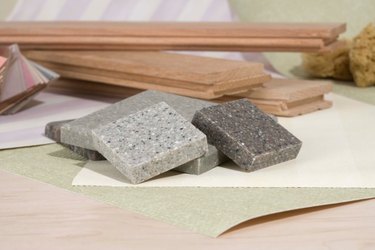Things You'll Need
5 ceramic tiles (per planter)
Clear sealing glaze
Paintbrush
Tile cement

Whether you can't find planters that match your décor or you want a modern style for your herb garden, handmade planters may provide a solution. Ceramic tiles left over from other projects work well, or you can choose a few specialty tiles from your local hardware store. Individual tiles usually cost less than $2, as of 2011, allowing you total color and design freedom for your container garden.
Step 1
Choose tiles with coordinating designs or colors. For instance, you could choose three solid green tiles and two tiles with a green damask or flower design on them. Always choose at least one solid colored tile for the bottom of your planter.
Video of the Day
Step 2
Lay out your tiles and clean them off with a mild cleanser. This removes dust and oil that could prevent the sealer from drying or keep the tiles from adhering to one another. Let them dry for about an hour.
Step 3
Paint the undecorated side and edges of each tile with sealer. This prevents the moisture from the plant soil from seeping into the tile and causing mold. Allow the sealer to dry overnight.
Step 4
Run a bead of tile cement up the left edge of one of your tiles. Press the right edge of a second tile into the cement, positioning the tiles to form a 90-degree angle. Add the other two tiles the same way, forming a hollow square box.
Step 5
Draw a bead of tile cement over the top edge of your hollow square box. Press your fifth tile into the bead as a lid for the box. Allow the planter to dry for about 24 hours and plant as desired.
Tip
If you have tiles left over from another project, you can customize them with scrapbooking paper. Glue the paper to each tile with craft glaze and paint a layer of craft glaze on top of the paper as well. Let the tiles dry overnight and assemble as above.
Video of the Day